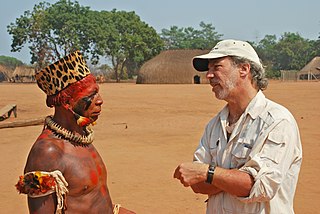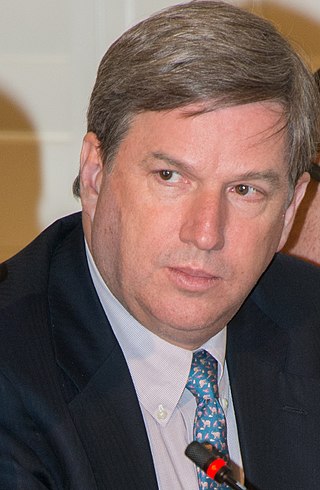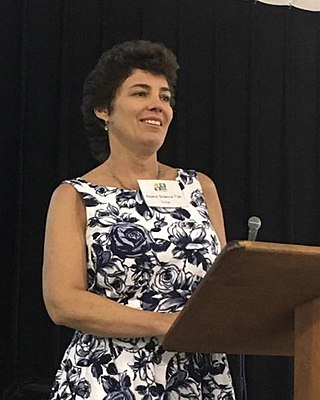Related Research Articles

Thomas Eugene Lovejoy III was an American ecologist who was President of the Amazon Biodiversity Center, a Senior Fellow at the United Nations Foundation and a university professor in the Environmental Science and Policy department at George Mason University. Lovejoy was the World Bank's chief biodiversity advisor and the lead specialist for environment for Latin America and the Caribbean as well as senior advisor to the president of the United Nations Foundation. In 2008, he also was the first Biodiversity Chair of the H. John Heinz III Center for Science, Economics and the Environment to 2013. Previously he served as president of the Heinz Center since May 2002. Lovejoy introduced the term biological diversity to the scientific community in 1980. He was a past chair of the Scientific Technical Advisory Panel (STAP) for the Global Environment Facility (GEF), the multibillion-dollar funding mechanism for developing countries in support of their obligations under international environmental conventions.
The conservation movement, also known as nature conservation, is a political, environmental, and social movement that seeks to manage and protect natural resources, including animal, fungus, and plant species as well as their habitat for the future. Conservationists are concerned with leaving the environment in a better state than the condition they found it in. Evidence-based conservation seeks to use high quality scientific evidence to make conservation efforts more effective.

Ecotourism is a form of tourism involving responsible travel to natural areas, conserving the environment, and improving the well-being of the local people. Its purpose may be to educate the traveler, to provide funds for ecological conservation, to directly benefit the economic development and political empowerment of local communities, or to foster respect for different cultures and for human rights. Since the 1980s, ecotourism has been considered a critical endeavor by environmentalists, so that future generations may experience destinations relatively untouched by human intervention. Ecotourism may focus on educating travelers on local environments and natural surroundings with an eye to ecological conservation. Some include in the definition of ecotourism the effort to produce economic opportunities that make conservation of natural resources financially possible.

Richard Evans Schultes was an American biologist. He may be considered the father of modern ethnobotany. He is known for his studies of the uses of plants by indigenous peoples, especially the indigenous peoples of the Americas. He worked on entheogenic or hallucinogenic plants, particularly in Mexico and the Amazon, involving lifelong collaborations with chemists. He had charismatic influence as an educator at Harvard University; several of his students and colleagues went on to write popular books and assume influential positions in museums, botanical gardens, and popular culture.

Bactris gasipaes is a species of palm native to the tropical forests of Central and South America. It is well spread in these regions, where it is often cultivated by smallholders in agroforestry systems or more rarely, in monoculture. Common names include peach palm in English, among others used in South American countries. It is a long-lived perennial plant that is productive for 50 to 75 years on average. Its population has an important genetic diversity, leading to numerous fruits, colors, and qualities. The fruits are edible and nutritious but need to be cooked for 30 minutes to five hours. They also benefit many animals in the wild. Peach-palms are also cultivated for the heart of palm, and the trunk can make valuable timber.

Mark J. Plotkin is an ethnobotanist and a plant explorer in the Neotropics, where he is an expert on rainforest ecosystems. Plotkin is an advocate for tropical rainforest conservation and host of Plants of the Gods: Hallucinogens, Healing, Culture and Conservation podcast.

Sarayaku is a territory and a village situated by the Bobonaza River in the province of Pastaza in the southern part of el Oriente, the Amazonic region of Ecuador. The territory incorporates a number of villages.

Lawrence Brilliant is an American epidemiologist, technologist, philanthropist, and author, who worked with the World Health Organization from 1973–1976 helping to successfully eradicate smallpox.

The great green macaw, also known as Buffon's macaw or the great military macaw, is a critically endangered Central and South America parrot found in Nicaragua, Honduras, Costa Rica, Panama, Colombia and Ecuador. Two allopatric subspecies are recognized; the nominate subspecies, Ara ambiguus ssp. ambiguus, occurs from Honduras to Colombia, while Ara ambiguus ssp. guayaquilensis appears to be endemic to remnants of dry forests on the southern Pacific coast of Ecuador. The nominate subspecies lives in the canopy of wet tropical forests and in Costa Rica is usually associated with the almendro tree, Dipteryx oleifera.

The Happy Planet Index (HPI) is an index of human well-being and environmental impact that was introduced by the New Economics Foundation in 2006. Each country's HPI value is a function of its average subjective life satisfaction, life expectancy at birth, and ecological footprint per capita. The exact function is a little more complex, but conceptually it approximates multiplying life satisfaction and life expectancy and dividing that by the ecological footprint. The index is weighted to give progressively higher scores to nations with lower ecological footprints.
The United Nations Environment Programme (UNEP) established Champions of the Earth in 2005 as an annual awards programme to recognize outstanding environmental leaders from the public and private sectors, and from civil society.
The Amazon Conservation Team (ACT) is a non-profit organization that works in partnership with indigenous people of tropical South America in conserving the biodiversity of the Amazon rainforest, as well as the culture and land of its indigenous people. ACT was formed in 1996 by ethnobotanist Mark Plotkin and Costa Rican conservationist Liliana Madrigal. The organization is primarily active in the northwest, northeast, and southern regions of the Amazon.

Dr. Martín von Hildebrand is an ethnologist and anthropologist who has led efforts to secure indigenous territorial rights and the protection of the Colombian Amazon tropical forest. He has been awarded the Right Livelihood Award, the Skoll Award for Social Entrepreneurship and The Order of the Golden Ark in recognition of his work with Fundacion Gaia Amazonas and the COAMA program.

Panthera Corporation, or Panthera, is a charitable organization devoted to preserving wild cats and their ecosystems around the globe. Founded in 2006, Panthera is devoted to the conservation of the world’s 40 species of wild cats and the vast ecosystems they inhabit. Their team of biologists, data scientists, law enforcement experts and wild cat advocates studies and protects the seven species of big cats: cheetahs, jaguars, leopards, lions, pumas, snow leopards and tigers. Panthera also creates targeted conservation strategies for the world’s most threatened and overlooked small cats, such as fishing cats, ocelots and Andean cats. The organization has offices in New York City and Europe, as well as offices in Mesoamerica, South America, Africa and Asia.

Cristián Samper is a Colombian-American tropical biologist specializing in conservation biology and environmental policy. He is the Managing Director and Leader of Nature Solutions at the Bezos Earth Fund. He served as President and CEO of WCS from 2012 to 2022. He was the Director of the Smithsonian Institution's National Museum of Natural History, the world's largest natural history collection, from 2003 to 2012, and served as acting Secretary of the Smithsonian from 2007 to 2008, the first Latin American to hold the position. In April 2015, Dr. Samper was inducted into the American Academy of Arts and Sciences.
Desarrollo Forestal Montreal S.A. is a nature reserve and cloud forest adjacent to Braulio Carrillo National Park in the central area of Costa Rica, about 30 miles (48 km) north of San José. The area is located between 1600–1800 meters (5,249–5,905 ft.) above sea level and extends throughout the mountain range.

Karen R. Lips is a Professor of Biology at University of Maryland, College Park. Lips' work in the 1990s eventually contributed to the identification of the chytrid fungus as the primary cause of frog decline worldwide.

Although the conservation movement developed in Europe in the 18th century, Costa Rica as a country has been heralded its champion in the current times. Costa Rica hosts an astonishing number of species, given its size, having more animal and plant species than the US and Canada combined while being only 250 miles long and 150 miles wide. A widely accepted theory for the origin of this unusual density of species is the free mixing of species from both North and South America occurring on this "inter-oceanic" and "inter-continental" landscape. Preserving the natural environment of this fragile landscape, therefore, has drawn the attention of many international scholars.

TheSloth Conservation Foundation (SloCo) is a non-profit organisation based in Costa Rica that is dedicated to the protection of sloths living in wild and human-modified habitats through research, education and community-based conservation. SloCo was founded in 2017 by sloth researcher Dr. Rebecca Cliffe.

Christine Figgener is a German marine conservation biologist, author, science communicator, and ocean advocate recognized for her work in sea turtle conservation, the fight against plastic pollution, and the empowerment of women in STEM. She is best known for documenting the removal of a plastic straw from a sea turtle's nose in a YouTube video that went viral in 2015. This video, which was featured in popular media outlets such as National Geographic, HuffPost, The New York Times, ABC News, and CNN, highlighted the dangers of plastic pollution on marine wildlife and was a catalyst for the global anti-straw movement that led to several straw bans by businesses such as Starbucks, Disney, and Alaska Airlines.
References
- ↑ "Liliana Madrigal". Amazon Conservation Team. Retrieved 26 January 2016.
- ↑ Allen, William (2003). Green Phoenix: Restoring the Tropical Forests of Guanacaste, Costa Rica. Oxford: Oxford University Press. p. 89. ISBN 0195161777.
- ↑ Dowie, Mark (2011). Conservation Refugees: The Hundred-Year Conflict between Global Conservation and Native Peoples . Cambridge, MA: MIT Press. p. 48. ISBN 9780262012614.
- ↑ "Liliana Madrigal". Skoll Foundation. Retrieved 26 January 2016.